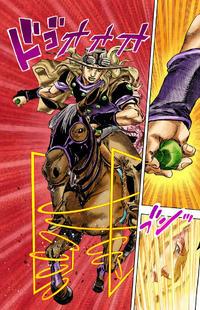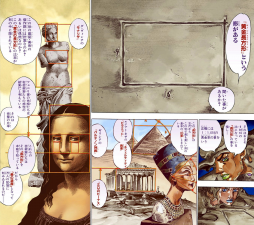Spin
The Spin (回転, Kaiten) is a physical phenomenon and technique of primary importance to protagonists Gyro Zeppeli and Johnny Joestar in Part VII: Steel Ball Run.
The Spin may be considered counterpart to the Hamon power featured in the original timeline.
Summary
The Spin is described as the extension of a basic property of nature.
As demonstrated and explained by Gyro Zeppeli, the technique often involves the use of the phalanges, hand, wrist, elbow and shoulder, to the entire body (and beyond) in spinning a ball and/or launching it with the aim of exploiting the Magnus effect (whereby in flight, a spinning ball, by deflecting air flow, curves from its principal flight path), calculating trajectories with reference to golden rectangles in the environment.
Tools
- See also: Steel Ball, Wrecking Ball and Tusk
Although a variety of objects are shown to be compatible with the Spin, Gyro prefers special Steel Balls; grooved, steel spheres characteristic of a baseball or boule, which he calls and shows to be something near the perfect tool for applying and maintaining Spin.
Gyro on one occasion is able to create a spinning sphere of water while underwater, deflecting Sandman's attack.Johnny Joestar's Stand Tusk, developed with Gyro's mentoring, boosts his ability for applying Spin, namely by directly spinning his fingernails and allowing him to forcefully project them; which, closer to his body, may be better still than Steel Balls. With the fine Spin produced by Tusk, Johnny may punch spiral holes in himself, relocating damage, or his entire body, choosing destinations and targeting enemies to an accuracy resembling a guided or homing path.
Golden Rectangle
The Spin may be enhanced with reference to the Golden Rectangle (黄金長方形, Ōgon Chōhōkei).Recursively divided into a square and another golden rectangle, a line curved through the opposite corners (or centers, according to Gyro)[1] of each square produces a golden spiral, which in theory continues forever. Emulating a golden spiral with a throw requires locating a golden rectangle as a reference in the environment (creating difficulty in an empty room or on a bare plain).
Super Spin
- See also: Ball Breaker and Tusk ACT 4
In Gyro's example: Allowing it to find a certain natural running speed, Gyro and Valkyrie form an extended golden rectangle, by which with his feet planted in his stirrups, Gyro may mount a supremely forceful, powerfully spinning throw.
A Steel Ball thrown with Super Spin can cut certain objects and on contact, numb an enemy's senses. Secondly, anything the Steel Ball hits will stick to it, as if attached.
Gyro's Ball Breaker and Johnny's Tusk ACT 4 appear representing the force of the Super Spin; both capable of bypassing the interdimensional barriers that hide and protect Funny Valentine and his Stand D4C.
Tactical vulnerabilities to this technique include that the horse requires a certain runway in order to find its idiosyncratic, "natural" speed, and the interception possible by slaying the horse.
Effects
Objects thrown with the Spin may have a range of effects on contact with humans or the environment.
Gyro uses the Spin extensively, for a range of destructive, defensive and other purposes. Spiral ripples appear in the flesh of human and animal targets, their muscles dominated by the force of the Spin. Harm may be deliberately inflicted to fine degrees, and flesh may be contorted in such a way that water is wrung from the body.
The Spin has been long studied as a human anatomical corrective and medical treatment by the Napoletani Zeppeli Family, doctors renowned throughout Italy, although they are employed by their government as executioners, able as they are to effect clean, certain and painless death.[2]
This section requires expansion.




